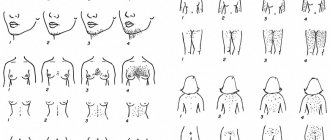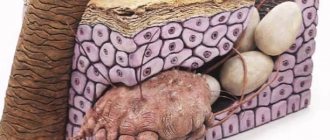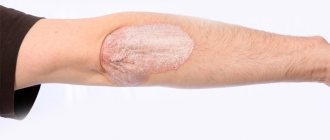Home » Services for women » Gynecology » Treatment of vulvitis in women
Vulvitis is an inflammatory process that affects the external genitalia of girls and women. The symptoms of the disease are unpleasant - pain during sexual intercourse or urination, burning, heavy vaginal discharge, swelling and itching. Often this pathology is caused by improper hygiene and hormonal imbalances.
Vulvitis in women with timely started therapy practically does not cause complications. If the disease occurs in a girl at an early age, it often provokes the development of a pathology such as fusion of the labia minora.
Causes of vulvitis
Against the background of severe viral infections, disruptions in the gastrointestinal tract and immunity, even a wet swimsuit or cold stool can cause vulvitis.
The development of vulvitis is provoked by:
- vegetoneurosis;
- tight clothes;
- increased sweating;
- synthetic pads and underwear;
- poor hygiene during menstruation;
- injury to the mucous membrane and skin in the pubic area;
- taking heavy antibiotics or a course of radiation therapy;
- constant humidity in the area of the external genitalia;
- maceration of the vulvar mucosa with secretions from the cervical canal or vagina;
- metabolic and hormonal dysfunctions: diabetes mellitus, vitamin deficiency, ovarian hypofunction, allergic reactions, obesity.
The risk of developing an inflammatory process is significantly increased by delicate mucous membranes, folds, and accumulation of blood vessels and nerve endings near the surface of the epidermis. In rare cases, vulvitis is diagnosed against the background of diphtheria, tuberculosis, or immunodeficiency.
Vulvitis is caused by the following infections and fungi:
- chlamydia;
- gonococci;
- helminths;
- Trichomonas;
- streptococci;
- staphylococci;
- coli;
- yeast fungi.
Reasons for the development of inflammatory processes in the female genital organs
Normally, the vaginal microflora is very diverse, which provides natural protection against infection. It contains lacto- and bifidobacteria, which are also called Dederlein's bacilli. They account for 90-95% of all normal vaginal microflora in women of reproductive age.
These microorganisms break down glycogen, which is present on the surface of the epithelial cells of the vaginal mucosa, resulting in the formation of lactic acid. It ensures the maintenance of an optimal acidic environment for the vagina with a pH in the range of 3.8-4.5, in which many microorganisms die, and therefore cannot cause infection and the development of the inflammatory process. Therefore, any manipulations, including the use of antibacterial or antimicrobial agents, that change the level of acidity in the vagina, can create the preconditions for the development of inflammatory diseases.
Normally, the pH in the vagina is higher in girls before puberty and in postmenopausal women, since the number of lactobacilli directly depends on the level of estrogen.
The remaining 5-10% are staphylococcus epidermidis, enterococci, hemolytic and non-hemolytic streptococcus. Normally, the vaginal microflora may also contain E. coli, yeast-like fungi, ureaplasma and mycoplasma, but due to the fact that the number of lacto- and bifidobacteria significantly exceeds their number, opportunistic microorganisms are not able to multiply and provoke the development of inflammatory diseases. Thus, the vaginal flora is a dynamic and completely self-regulating system, any interference in which can lead to the development of nonspecific inflammatory processes.
Expert Opinion of a Doctor
Undoubtedly, the most important cause of inflammatory diseases of the genitals are various microorganisms that penetrate the genital tract of women. Also, general diseases contribute to the occurrence of inflammatory diseases of the uterine appendages; great physical activity and mental stress; stressful situations; allergic reactions. Extreme concern is caused by the steady increase in sexually transmitted diseases, especially the so-called latent infections caused by chlamydia, ureoplasma, and mycoplasma.
Women's inflammatory diseases
Experience:
Ask a Question
In addition to the irrational use of antibacterial and antiseptic agents, violations of the rules of hygiene procedures, the following can provoke inflammation:
- transmission of other infectious diseases, including acute respiratory viral infections and others, leading to a decrease in immunity;
- hormonal disorders;
- incorrect selection of hormonal contraceptives, including intrauterine devices;
- taking a number of medications (cytostatics, antibiotics).
Even if microorganisms managed to provoke inflammation in the lower parts of the genital organs, the cervical canal, which normally has virtually no lumen, is designed to protect the upper parts from involvement in the pathological process. In addition to its natural narrowness, the cervix contains a large amount of mucus, saturated with nonspecific protective factors. Thanks to it, the vast majority of pathogens cannot penetrate the uterus further and provoke inflammation.
However, infections and inflammatory diseases of the uterus, ovaries and fallopian tubes are also common. Their occurrence is facilitated by:
- intrauterine manipulation, including diagnostic curettage, abortion, removal of tumors, etc.;
- sexual intercourse during menstruation, when the cervical canal expands for natural reasons and loses some mucus;
- childbirth;
- surgical interventions on the pelvic and abdominal organs;
- chronic infections;
- stress;
- hypothermia.
All this can lead to changes in the natural mechanisms of protection of the internal genital organs and create favorable conditions for their infection by opportunistic or pathogenic microorganisms with the subsequent development of an inflammatory disease.
Types of vulvitis
There are two types of the disease:
- primary vulvitis;
- secondary vulvitis.
If the cause of the development of the inflammatory process of the vulva is the organs of the reproductive and excretory system (bladder, tonsils, kidneys, vagina, uterus), secondary vulvitis is diagnosed. In this case, the main therapy should be aimed at the source of infection, and then at the treatment of the external genitalia. As a rule, secondary vulvitis occurs against the background of existing inflammation: cervicitis, endocervicitis, colpitis.
Primary vulvitis is common during the formation of the reproductive system, hormonal maturation, and postmenopause. This clinical picture of the disease is associated with the characteristics of the female reproductive system. In little girls with unformed local immunity, primary vulvitis often develops due to pinworms.
When the level of estrogen in women decreases (during menopause), atrophy and thinning of the vulvar mucosa occurs, the protective function decreases, and vaginal discharge decreases. Hormonal changes in the body can trigger the development of vulvitis.
In women of reproductive age with a healthy hormonal background, physiological microflora and Ph-secretion, primary vulvitis is unlikely; in rare cases, vulvovaginitis is diagnosed.
Indications for the disease
A number of doctor's indications for this disease will help alleviate symptoms and recover faster.
If you have vulvovaginitis in childhood, you should not ignore the testimony of specialists. They relate to general health measures, elimination of foci of chronic infection, and personal hygiene.
In older women, vulvovaginitis develops against the background of physiological changes in the vaginal mucosa. To relieve the symptoms of vulvovaginitis, they are shown sitz baths and douching with herbal decoctions, antiseptic solutions, and the use of vaginal suppositories. Treatment of underlying pathological conditions is required to reduce allergic mood, correct glycemic levels in diabetes mellitus, sanitize infectious foci, etc.
If specific vulvovaginitis is detected, treatment of the sexual partner is required. Sexual rest is required until the end of treatment.
Correction of nutrition, normalization of weight, and changes in hygiene habits are also important. In certain cases, the elimination of provoking factors leads to a permanent cure of vulvovaginitis without subsequent relapses. To monitor the situation after a course of therapy, a control bacterioscopic and microbiological analysis of discharge from the genital tract is performed.
Signs of vulvitis
In gynecology, a distinction is made between chronic and acute forms of the disease. The photo of a patient with vulvitis clearly shows hyperemia, redness and modified mucous membrane.
Signs of acute vulvitis:
- swelling of the clitoris;
- itching and burning of the vulva;
- redness of the labia;
- enlargement of sebaceous glands;
- the appearance of ulcers and erosions;
- painful urination;
- roughness of the labia minora;
- bloody or serous-purulent discharge;
- damage to the inguinal folds (in rare cases);
- blisters with fluid (herpetic vulvitis);
- enlarged lymph nodes in the groin, sometimes an increase in temperature may be recorded;
- curdled, yellow-green or white discharge of a watery nature (if the cause of vulvitis is E. coli, staphylococcus).
Manifestations of chronic vulvitis:
- swelling of the vulva;
- itching and discharge;
- epithelial defects;
- hyperemia on the vulva;
- redness of mucous membranes;
- hypertrophy of the sebaceous glands.
Vulvovaginitis: drugs
Local and oral agents are used for treatment.
Vaginal suppositories and creams (Gynex, Clotrimazole, Lomixin) are indicated as local ones. Doctors also prescribe a course of tablet antibiotics (Pancef, etc.). For candidal etiology, antifungal agents are prescribed: Nystatin, Fluconazole, Itraconazole, Metronidazole.
Upon completion of treatment, doctors recommend taking probiotics (Lactozhinal, etc.) to restore the microflora.
If the cause of the disease is worms, anthelmintic drugs are needed: Aldazole, Pirantel.
Consequences of vulvitis
The acute form of vulvitis in children is accompanied by nervous excitability and sleep disturbances. If diagnosis and treatment are not timely, the disease develops into a relapsing chronic form.
As a result of vulvitis suffered by a girl at an early age, genital deformities develop and fusion of the labia minora (synechia) occurs. Untreated chronic inflammation can subsequently cause anorgasmia, miscarriages, and infertility.
If you experience similar symptoms, consult your doctor
. It is easier to prevent a disease than to deal with the consequences.
Doctors treating this disease
Which doctor treats this condition? If you suspect any type of vaginitis, women need to make an appointment with a gynecologist at a antenatal clinic or a private medical center to choose the most effective method of therapy. Since vaginitis is treated on an outpatient basis, it makes no sense to go to the gynecological departments of city and regional hospitals. In order to clarify the diagnosis of recurrent vulvovaginitis and perform additional studies, consultation with specialized specialists may be required: venereologist, allergist, endocrinologist, urologist, etc.
Diagnosis of vulvitis
The diagnosis of vulvitis is made based on examination of the patient’s external genitalia. For an accurate diagnosis, the gynecologist uses a hand-held magnifying glass, conducts vaginal-abdominal and rectal examinations, takes a smear for cytology, and examines peripheral lymph nodes.
To identify the causes of the inflammatory process, additional diagnostics are required:
- Analysis of urine;
- vulvoscopy;
- HIV test, RW;
- general blood analysis;
- cultural sowing;
- bacterioscopy of smears;
- tests for helminths (feces or blood).
Symptoms and stages of the disease
Atrophy can be recognized by several signs that appear and develop over the course of the disease:
- sore genitals;
- burning sensation, skin tightening;
- patients are concerned about itching, which tends to intensify over time;
- discomfort and pain are felt during sexual intercourse;
- Sleep disturbances and mental disorders may occur as accompanying symptoms.
Signs and symptoms appear gradually. There are three stages of development of vulvar atrophy:
- swelling and redness of the genital organs occurs, which indicates microcirculation disorders in the tissues;
- the skin becomes dry and rough, as does the mucous membrane, the labia majora and minora become flattened, you may notice the appearance of pigmentation and white scales in the intimate area, hair growth stops, and severe itching occurs;
- atrophy is clearly noticeable - the genitals shrink, cracks may appear, the vagina narrows, as does the external urethra and anus. This makes sexual intercourse painful and also makes urination and bowel movements difficult.
Treatment of vulvitis
Complex therapy for inflammation of the external genitalia includes:
- drug correction;
- intravaginal irrigation and baths;
- supportive therapy (homeopathy, hormones, macroelements, vitamins, immunostimulants).
During treatment, women are advised to refrain from sexual intercourse, going to the pool and the beach, and are prohibited from using vaginal tampons and panty liners. If a bacterial source of vulvitis is identified (candidiasis, tuberculosis, gonorrhea, chlamydia, trichomonas fungus), appropriate medications are prescribed (injections, tablets, suppositories, creams).
In little girls, in most cases, inflammation of the labia is provoked by opportunistic microflora. The photo of vulvitis in children shows redness not only in the area of the external genitalia, but also inflammation in the inguinal folds, on the thighs and buttocks. The gynecologist prescribes local antibiotics in the form of ointments and baths with anti-inflammatory herbs (chamomile, calendula, string, eucalyptus).
To relieve symptoms of acute vulvitis, the following therapeutic methods are used:
- Ural Federal District;
- hydrocortisone ointment;
- anti-inflammatory suppositories;
- baths with herbs and potassium permanganate;
- compresses with Furacilin, lead water, eucalyptus infusion;
- irrigation of the external genitalia with potassium permanganate, boric acid solution;
- the use of powders with streptocide, camphor, folliculin, zinc oxide, talc, anesthesin.
If vulvitis is allergic, antihistamines and dietary supplements are prescribed.
How to treat vulvitis in girls
Vulvitis in girls must be treated with special care. Treatment begins immediately after the examination, since the child suffers greatly from the symptoms of the disease. Treatment for children should be comprehensive (general and local). Special powders and sitz baths with a pale pink solution of potassium permanganate, antibiotics, anthelmintics and vitamins are recommended.
Vulvitis during pregnancy
During pregnancy, the body begins to produce hormones that promote growth, fetal formation and a favorable course of pregnancy. All endocrine glands of the body are completely rebuilt: reproductive, thyroid, adrenal glands, pituitary gland. At the same time, the adrenal glands sharply increase the production of glucocorticoids and mineralocorticoids, which suppress the mother’s immunity to preserve the fetus.
The most common causes of vulvitis in pregnant women are yeast, E. coli, staphylococci and streptococci. In the first and second trimesters of pregnancy, candidal vulvitis, hyperpigmentation and striae formation are often diagnosed. The gynecologist must select the optimal therapy for the pregnant woman and a set of supportive procedures to prevent relapses. Untreated vulvitis can lead to infection of the fetus during passage through the birth canal.
Folk remedies for treating vulvitis
It should be noted that herbal infusions, plant juice and any homeopathic medicines are not able to cure vulvitis, which is caused by gonorrhea, trichomonas fungus, tuberculosis, herpes, staphylococcus or chlamydia. Folk remedies help only with the non-infectious nature of the disease.
Proven anti-inflammatory and immunostimulating agents:
- Kalina. A tablespoon of dried inflorescences is poured into a glass of water and kept in a steam bath for 8-10 minutes. The strained decoction should be taken three times a day, one tablespoon at a time.
- Stinging nettle. Young nettle leaf juice is taken one teaspoon three times a day.
- St. John's wort. A tablespoon of dried collection is poured with a glass of boiling water and left for 40-50 minutes. The decoction is filtered and drunk 50 ml three times a day.
- Wintergreen round-leaved. The succulent leaves of the plant are doused with boiling water, crushed and applied to the vulva for 5-10 minutes. Such phytoapplications are good at relieving itching, burning and hyperemia of the mucous membrane.
- Lungwort. Freshly squeezed juice of the leaves of the plant is diluted 50/50 with water and applications are made to the vulva twice a day. Lungwort has anti-inflammatory and antiseptic effects.
Preventive actions
The basis for the prevention of vulvitis and other genitourinary diseases in girls is teaching children the rules of intimate safety and hygiene. Parents of children need to monitor:
- daily washing before bed and after defecation with warm, clean water using soap or other products no more than 3-4 times a week;
- timely change of diapers;
- wearing loose, non-tight clothing and underwear made from natural fabrics;
- providing girls with personal care products: towel, soap, washcloth;
- wearing panties or swimwear on the beach.
Adolescent girls also need to be told in a timely manner about the dangers of unprotected sexual relations.
If your daughter has symptoms of vulvitis, the pediatric gynecologists of the SM-Doctor clinic will conduct the most delicate examination and prescribe the necessary diagnostic procedures and treatment measures. Remember, the lack of timely treatment can cause the process to become chronic and cause ascending infection of the vagina, uterus, and bladder.
Depending on the nature of the pathology, the following are used:
- medications that act on infectious agents;
- painkillers and anti-inflammatory ointments that relieve swelling, burning and itching;
- sitz baths with medicinal ingredients;
- hygienic washing with antiseptic solutions;
- physiotherapeutic techniques.
In the case of allergic vulvitis, a thorough analysis of the child’s environment is carried out, possible allergens are identified and eliminated: diapers, clothes, detergents, food. To relieve symptoms and relieve itching, general and local antihistamines are prescribed.
Prevention of vulvitis
Girls should be taught to properly care for their genitals from birth. Regular washing with non-alkaline compounds, clean linen and proper hygiene of the child after using the toilet can prevent inflammatory and serious infectious diseases of the reproductive system.
The basis of prevention is compliance with three simple rules:
- underwear made from natural materials;
- healthy lifestyle;
- hygiene.
This article is posted for educational purposes only and does not constitute scientific material or professional medical advice.
Vulvovaginitis
Vulvovaginitis is a disease of the female genital organs.
Inflammation may be of bacterial origin or be the result of mechanical irritation of the vulvar and vaginal mucosa. The natural structure of the female body allows us to protect the genitals from microorganisms from the external environment. The vaginal microflora of a healthy woman easily inhibits the growth of opportunistic bacteria that live on the mucous membranes. A decrease in immunity due to stress, intoxication or a viral disease can provoke a surge in the activity of pathogens, resulting in the development of acute vulvovaginitis.
Reviews
Author, 06/24/2016
Hello! The story is like this. Candidiasis, that is, thrush, has been tormenting me for a long time. Flucostat is effective for two days for a maximum of a week. I contacted doctors. The last doctor prescribed a diet and a long course of treatment. Apply clotrimazole externally for 21 days, Viferon suppositories, then a one-time application, five Revita tablets taken internally for a month (so that ascorbic acid restores the microflora). And in the end, two weeks after the end of treatment, the finish is complete again. Everyone stupidly advises using soda the old fashioned way, but I’m afraid of experiments. Who was in such a situation and won this byaku? Please share your experience.
Irina, 08/15/2016
Oh, how familiar this problem is to me, nothing helps. There are probably no medications that I haven’t tried. I took smears and culture tests 100 times. I did everything as prescribed by the doctor. After treatment with antifungal drugs, I took probiotics and put on suppositories. I also tried folk remedies. I donated blood. It seemed like the norm was the last time (albeit a year ago). I’ve been suffering from this infection for about 15 years. At first there were relapses once every six months, then after a month or two, now a week after the end of treatment. I don’t know what to do. I’ll go to the doctor again. But I don’t believe it anymore. All this time I did what they told me. How much money I spent, I’m generally silent. And I tried expensive medications and their analogues. They brought it to me from abroad. I constantly deal with this garbage. I don’t believe that anything will help. More like a cry from the heart. I finished another course of treatment a week ago. Here we go again...
Alena, 35 years old, September 20, 2016
I had thrush for about 9 years. I read medical articles about this, itraconazole helped me, but I took it for about a week at the same time as Terzhinan suppositories for 10 days, after that Vaginorm for 6 days along with ecofemin in tablets, and don’t expect to be cured in one month, further 3 months, fluconazole once a week, and do not stop repeating Vaginorm and Ecofemin after menstruation, and then depending on the situation, as soon as I feel that something is starting again, terzhinan suppositories and Ecofemin lactobacilli, constant monitoring, but for almost a year there have been no fungus in tests)!









